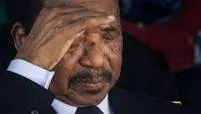On Saturday, November 6, President Biya will clock 39 years at the helm of the Republic of Cameroon, thereby emerging as Africa’s second longest reigning Presidents.
He is only beaten by Teodoro Obiang Nguema of Equatorial Guinea, who has been in power for 42 years – since August 1979.
88-year-old Biya first rose to Cameroon’s top seat on November 6, 1982, when a large number of the country’s 26.5 million citizens were not yet born. He inherited a country of 9.2 million people from Ahmadou Ahidjo, the first president.
Coming from a humble background, Biya was swept to the pinnacle of power by a conspiracy of circumstances when the former President, Amadou Ahidjo, resigned on November, 4, 1982.
By the time the octogenarian President exhausts his mandate in 2025, he would have savoured 44 long years in power.
According to an article in East African Magazine, Biya is one of Africa’s Presidential “sit-tighters” who have seemingly eternalised their stay in power through fraudulent elections.
Biya, who is 88 (he will be 89 in February) is the oldest African President.
After being offered power virtually on a platter of gold, on that fateful day of November 6, 1982, Biya gave a veneer of legitimacy to his mandate when he was elected President on January 14, 1984, without any challenger. The New Deal apostle got his second mandate on April 24, 1988, when he was elected yet without any challenger in a monolithic election.
It was only on October 11, 1992 that Biya faced a tough challenger, SDF’s John Fru Ndi when he sought his third mandate. Going by results proclaimed by the Supreme Court, President Biya was re-elected with 39.9 percent of votes while Fru Ndi had 35.9 percent. It was widely believed that the authorities ‘doctored’ the results, thereby cheating the leading opposition leader of victory.
Following the amendment of the constitution on January 18, 1996, the mandate of the President was increased from five to seven years renewable once. Biya had no difficulties grabbing his fourth mandate following the boycott of the October 12, 1997 Presidential election by the SDF.
He obtained the fifth mandate in the presidential election of October 11, 2004. On April 10, 2008, Biya used the CPDM-dominated National Assembly to amend the constitution, thereby abrogating the article that provided a limitation to presidential mandates. This amendment enabled him to grab his sixth mandate in the 2011 presidential election.
Biya’s fresh thorns appeared following the contested 2018 presidential elections. Although the Constitutional Council said Biya won the polls by 71 percent, his major challenger, Prof. Maurice Kamto of the Cameroon Renaissance Movement (CRM) has continued to claim victory over the elections.
Even before the post-2018 Presidential election wahala, the crisis in the North West and South West Regions which started in late 2016 became a hot potato in Biya’s throat when it transformed into an armed conflict in 2017. They war against Boko Haram in the Far North Region has also not been won by despot Biya and his totalitarian military.
Cameroon which is grappling with economic and security woes is expected to host the 2021 African Football Cup of Nations (AFCON2021) in January and February 2022. Initially expected to host in 2019, Cameroon had its hosting rights deferred due to her habitual unpreparedness.
Humble Beginning
Biya, the man who is crushing anglophones with an iron fist was ironically born to a celebrated roman Catholic famil.
Etienne Mvondo Assam, a catechist, sired Paul Barthelemy Biya bi Mvondo in 1933 in Mvomeka village in the Dja and Lobo Division of the South Region. Coming from a devout Catholic family, the young Biya wanted to be a priest. He attended the St. Tharcissius Seminary at Edea in the Littoral Region and St. Joseph at Akono in the Centre Region.
Circumstances virtually aborted Biya’s priesthood pursuit. He bagged his baccalaureate in the Philosophy series from Lyceé General Leclerc in Yaounde in 1956. He later studied at Lyceé Louis le Grand in Paris, France and enrolled at the University of Sorbonne, Paris, where he bagged a degree in Public Law. Biya equally obtained many certificates of higher learning in many disciplines before returning to Cameroon in 1962. That same year, he was appointed chargé de mission at the Presidency of the Republic.
From January 1964 to July 1965, Biya was the Director of Cabinet to the Minister of National Education, Youth and Culture. He later rose to the rank of Secretary General in that same ministry. In December 1967, President Amadou Ahidjo appointed Biya the Director of Civil Cabinet at the Presidency. He held that position cumulatively with that of the Secretary General at the Presidency in 1968.
In June 1970, Biya was appointed Minister of State, Secretary General at the Presidency. President Ahidjo promoted him to Prime Minister in June 1975. And it was not until June 1979 that Parliament enacted law no. 79/02 of June 29, 1979, making the Prime Minister the constitutional successor of the President of the Republic. By a sheer wind of circumstances, Ahidjo resigned on November 4, 1982 and Biya was sworn in as President of the Republic two days later.
Biya is considered by observers as one of the presidential Methuselah of Africa. Since 1982, a country like China that is considered undemocratic, has had five presidents; Neighbouring, eight Presidents – Gen. Muhammadu Buhari-1982 to 1985, Gen. Ibrahim Badamasi Babangida-1985 to 1993, Ernest Shonekan-August to November 1993, Gen. Sani Abacha-1993 to 1998, Gen. Abdulsalami Abubakar-1998 to 1999, Chief Olusegun Obassanjo-1999 to 2007, Alhadji Musa Yar’ Adua-2007 to 2010 and Dr. Goodluck Jonathan from 2010 and Buhari since 2015.
The US has had seven Presidents: Ronald Wilson Reagan-1982 to 1989, George Herbert W. Bush-1989 to 1993, Bill Clinton-1993 to 2001, George Walker Bush-2001 to 2009, President Barack Obama from 2009 to 2017, Donald Trump from 2017 to 2021 and now President Joe Biden since 2021.
Children who were born in 1982 in Cameroon are 39 years old today. They know only one President – Biya.



